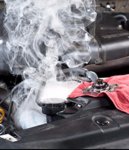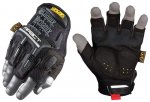My day was (eventually) better than Ron's, so my lack-of-progress report actually includes some progress.
Following my own advice and using a small wire brush on the cordless drill to de-paint the last bolt, and resorting to leg power on the 2-foot 3/4-inch drive ratchet, the second axle locating link finally came off.
Had manual labor not worked, the alternative was to cold start the M1009 (which lost a freeze plug two days ago) to get it out of the way, to then cold start the M1008 to jump the parts SEE (yes, another cold start) to use the hydraulic impact. Which would've then put 10W oil in my new hydraulic impact, with AW 32 in it. I hate cold starts.
But the best part was that last night I remembered that I have a cheap HF "tubing bender" (which I tried once, many years ago, and was very disappointed with).
Well, not only did I find it,
and the dies, but it was perfect for straightening out the forklift bends with. I tried with a regular press yesterday, and ended up deforming the tubing.
For those of you with forklift damage underneath, I strongly recommend using a tubing bender of some sort. My good one is still not unpacked, and I think this cheapy actually works better for this.
![DSCN1238[1].jpg DSCN1238[1].jpg](https://www.steelsoldiers.com/data/attachments/437/437285-b37ce7c1192b851241ee12b40f342cf1.jpg)
Edit: The link in the foreground was the least damaged, the one that looks somewhat straight now was pretty bad.



![DSCN1238[1].jpg DSCN1238[1].jpg](https://www.steelsoldiers.com/data/attachments/437/437285-b37ce7c1192b851241ee12b40f342cf1.jpg)

